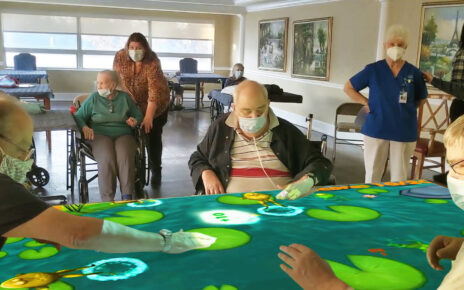Interview with Jenna Kellerman, Director of Workforce Strategy & Development, LeadingAge
 Tell us about your new role at LeadingAge and what you’re excited to work on this year.
Tell us about your new role at LeadingAge and what you’re excited to work on this year.
I’ve been in the role exactly one month! So, I’m still getting into things. I’ve been learning how workforce is embedded in every department of LeadingAge – there are so many ongoing initiatives within this organization. Part of what I’ll be doing is helping to coordinate all those efforts and making sure that all these different areas are working towards a common strategy or common goal and helping providers access resources. We’re focusing on caregiving professionals and those staff that are closest to the older adults served. We will also focus on the leadership side of things, because good leaders are key to a successful workforce in the field.
In my current role, I am able to advance workforce solutions at a national level. Although there’s a lot of workforce solutions that state partners can influence, some of the core issues that need to change are at the federal and national level. I am excited to join the LeadingAge team to address these issues.
Can you touch on what needs to change at the federal and national level?
Two significant workforce needs that require federal attention are wages and immigration. We simply have to pay caregiving professionals living wages. We can no longer accept poverty level wages for so many caregivers in our field. Reimbursement rates have not kept up with the cost of care and services and we need our lawmakers to recognize this and work with providers on adequate reimbursement that can translate into providing a living wage to staff.
Providers can’t do this alone – they need support from lawmakers. It’s how our reimbursement structure is set. They have to understand the cost of our care and understand that our caregiving professionals are not “low-skilled, low wage workers.” Caregiving professionals go through a significant amount of initial and ongoing training to do what they do – it is a professional level job. As acuity of residents increases, so does the training need. Wages need to match the skill level, which is high in our field.
Immigration is another federal-level issue that is key to our workforce solutions, and the advocacy team at LeadingAge is supporting creative efforts in this area, including advocating for modifying and expanding certain visa programs, addressing the visa backlog, and expediting the visa application proves for foreign-trained nurses.
How do you think employers can engage and attract people to the field in the face of challenges like low wages?
Strengthening the career pathways in our field is important. We have career pathways in our field that are very clear. You can be a nursing assistant, become a Medication Aide, LVN, RN, Manager, Director of Nursing. There are similar pathways in culinary, housekeeping, and social work. But what’s interesting is when you look at the diversity of our caregiving professionals, it’s a hugely diverse population. And then when you look at leaders in the executive level, C-Suite, and Board level – they’re nearly all white.
LeadingAge has done research on the executives in our field and there’s very little diversity at the executive level. So, although we can articulate what the career pathways are, they aren’t equally accessible to everyone. If they were, our leadership would be as diverse as the frontline staff. So, I think there is incredible opportunity to build the skills and leadership abilities of our workforce and promote them through the pathways that exist. That’s important when it comes to communicating about our field – working with our leaders to make sure we’re really opening doors for everyone and creating cultures and environments that are inclusive for everyone to grow in their careers and deepen their expertise.
Who do you typically outreach to during Careers in Aging Week, which just happened this past April?
What’s cool is that it brings together so many large groups, coalitions, businesses, associations, and providers to promote careers in the field of aging. It’s all of our organizations coming together with the same unified message. Provider members are especially important because they can reach out to schools, universities, and other community partners in their area.
How about careers that aren’t healthcare-related?
I think it’s very important for students to know about the wide range of careers available within aging services. Many people think of nursing when they think of aging services, but there are so many different career paths! If you visit a long-term care community, it really is like its own town. They need people in marketing, accounting, environmental services, social media, clinical services, administration, rehabilitation, culinary, and other areas. Any of these careers that exist in the world exist in this little microcosm that is a nursing home, assisted living, or other setting. Any interest, experience, or degree you have can translate into a career in aging.
And I think our field is special because there’s a mission-driven piece to it. No matter what your job title is, you can spend time with older adults and have that sense of purpose. You get to go home at the end of each workday and know you’ve made a difference in someone’s life.
Do you see any new emerging careers happening within the field?
As people continue to want to live at home, I think the workforce shortage is really going to impact that. I’d love to see long-term care employing more CTOs or CIOs to help move our technological use forward. Technology and telehealth positions will be important. We know some providers are experimenting with robotics in culinary and housekeeping. We are also interested in exploring additional social work positions in assisted living environments, and the ability to use caregivers more universally across service lines.
What does a successful Careers in Aging Week look like to you?
To make Careers in Aging week successful, we need as many organizations jumping in as possible to share all the social media messages, to connect with their local schools and give presentations, to get students in for an open house, or job shadowing. As much involvement as we can get! It’s important to do pipeline building work all year long, but during Careers in Aging week, we can all work together to saturate the media with a common message about careers in our field.
RESOURCES:




